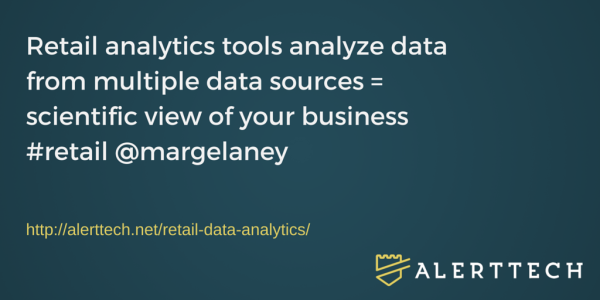Is your company fully utilizing the capabilities of retail analytics tools to gather and report critical information?
Retail data analytics provides business owners with statistical facts and figures that allow you to investigate how well your business is doing and where it needs to focus its attention to improve performance. Smart business owners and managers base strategy decisions on facts and have embraced the capabilities of retail data analytics tools to improve their information gathering and reporting.
Using retail analytics, you can compile many different pieces of high-value data from multiple sources and bring it all together to form a comprehensive view of your business.
8 top sources of information for retail data analytics are:
- POS systems
- Video cameras
- Mobile devices
- Sensors
- Weather reports
- Time and attendance systems
- Wi-Fi infrastructure
- Promotional calendars
Let’s take a look into how these data sources can help your business gather data and compile retail analytics.
[xyz-ihs snippet=”TOFU2-Retail-Technology-button”]
1) POS Systems
Your point of sale system is typically your cash register. The types of data gathered by a POS include:
- Types of items sold
- Prices of items sold
- Total sales for the day
- Total sales by category
- Customer data
This data can be added to your retail analytics tool to identify your best customers, determine which items are selling the best and which ones you might want to consider discontinuing. It also tells you which days of the week are the busiest and which times of day are your best for turning a profit.
2) Video Cameras
Did you install video cameras as a theft deterrent? Now you can put those cameras into a profit multiplier!
Use the video to monitor the number of people coming into the store, their store navigation patterns, and their buying habits. You can analyze what departments are the most widely visited and which routes people take through your business. This allows you to strategically place your merchandise to make sure that popular and promotional items are easy to find and also to determine the best placement for upsell items.
3) Mobile Devices
Customers will often use their mobile device to visit your website online. You can use this data to track how many people are visiting your website and what web pages they are visiting the most. Mobile data provides another source of data to determine which products are most popular and which products are the subject of ‘showrooming’. Showrooming occurs when customers go to a physical store to see or try on merchandise but then price shop and buy online.
4) People Counters
People counting sensors can keep a running count of how many people come into the store on any given day. This statistic can help you determine whether you should have your business open during certain hours and on certain days. Sensors are a simple way to monitor the traffic in your retail stores.
5) Weather Reports
Weather reports can be used to estimate traffic numbers. If the weather is cold, snowing and windy, people aren’t as likely to head out to shop. On the other hand, when the weather is hot, people often flock to nice, air conditioned stores. 
6) Time and Attendance Systems
Use time and attendance systems to keep track of staffing levels and break times. When combined with wait time tracking, this data will help you determine proper staffing levels to ensure optimum customer service levels.
7) Wi-Fi Infrastructure
Your Wi-Fi infrastructure will tell you how many people logged onto your Internet connection at any point in time. The more people using your connection, the more customers you have in your store.
8) Promotional Calendars
Combining your promotional calendar with your retail analytics allows you to monitor which specials are doing the best and which ones should be discarded. All promotions should have a unique tracking code!
[Tweet “8 High-Value Sources of Data for Retail Analytics #retail @alerttechinc”]
[xyz-ihs snippet=”TOFU2-Retail-Technology-button”]
Conclusion
With so many different options available to monitor your retail analytics, you can easily see where to best invest your time and efforts to help your enterprise succeed. Don’t overlook all of the possibilities available to you and your business. By compiling all of the sources together, you can create a detailed report that can help increase your bottom line.
Ready to put a comprehensive retail analytics program together for your company? Learn how when you download the whitepaper below.
[xyz-ihs snippet=”TOFU2-Retail-Analytics”]
